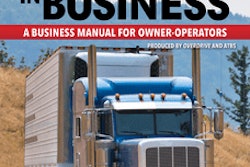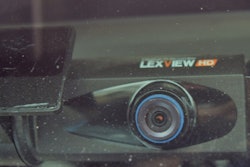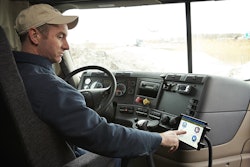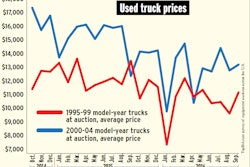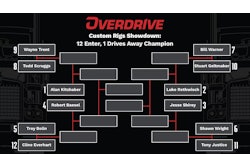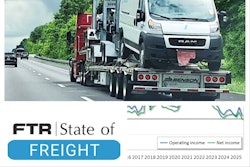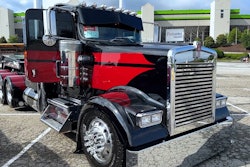Prior reports in this installment of the E-log Shift series, a look at the market for pre-2000 trucks in light of the electronic-logging-device mandate’s exemption:
Over the last decade, many larger fleets have adopted electronic logs for two principle reasons:
• The advantages – reduced violations, ancillary features allowing for more efficient dispatch and more – were worth the costs in their calculations.
• The fleets expected a government mandate and other industry pressures, so they decided to convert on their own timetable.
The same rationales might well affect owner-operators, as some observers see it.
While many owner-operators continue to resist ELD use, in some cases pinning their hopes on the pre-2000 truck exemption, remaining a holdout could prove problematic.
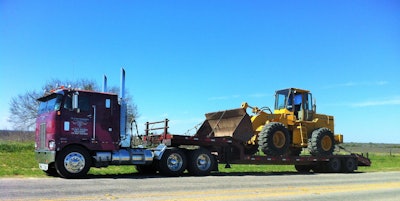 11.8% — That’s the overall pre-2000-truck share of total operating Class 8s on the road today, according to RigDig Business Intelligence, a sister business of Overdrive. Such small numbers – and smaller non-ELD carriers’ control of more than half of the pre-2000 units – leads FTR Transportation Intelligence COO Jonathan Starks to conclude that the market for such vehicles “will be very sparse. If somebody has an old truck that is in that good of shape and they don’t like the ELD rule, they aren’t selling.” Small fleet owner David Morin suggests a lot of such equipment could be subpar, given many engine rebuilders “don’t know their a– from their elbow.” He did manage to find a good runner early in 2016, though, a story told in part at this link. “I’d rather buy a truck that is in a junkyard, blown up or whatever, and pull it out and rebuild it so I know what I’ve got,” something he believes may be happening a lot over the next year. “If I was younger and this mandate went through, that’s what I’d have been doing – I’d do it properly and would take pictures all the way through so that I could show, ‘Here’s living proof of what I’ve done to that truck'” when he went to re-sell, if he went to re-sell.
11.8% — That’s the overall pre-2000-truck share of total operating Class 8s on the road today, according to RigDig Business Intelligence, a sister business of Overdrive. Such small numbers – and smaller non-ELD carriers’ control of more than half of the pre-2000 units – leads FTR Transportation Intelligence COO Jonathan Starks to conclude that the market for such vehicles “will be very sparse. If somebody has an old truck that is in that good of shape and they don’t like the ELD rule, they aren’t selling.” Small fleet owner David Morin suggests a lot of such equipment could be subpar, given many engine rebuilders “don’t know their a– from their elbow.” He did manage to find a good runner early in 2016, though, a story told in part at this link. “I’d rather buy a truck that is in a junkyard, blown up or whatever, and pull it out and rebuild it so I know what I’ve got,” something he believes may be happening a lot over the next year. “If I was younger and this mandate went through, that’s what I’d have been doing – I’d do it properly and would take pictures all the way through so that I could show, ‘Here’s living proof of what I’ve done to that truck'” when he went to re-sell, if he went to re-sell.Some shippers may favor ELD use over paper once the mandate is in place, says Craig Kendall, president of the Used Truck Association. Referencing specifically hazmat loads and their enhanced security/safety needs, he says, “Government might not require ELDs, but for the hazmat haulers not using the electronic logs, maybe their customers will dictate it.”
FTR Transportation Intelligence Chief Operating Officer Jonathan Starks extends this view from shipper customers to brokers. Within 24 months of the ELD mandate going into effect, he believes, “nearly everyone will need an ELD, whether they like it or not, purely from a market standpoint.”
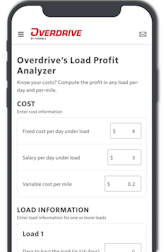
Starks believes shippers and brokers will require ELDs and/or other functions, such as real-time tracking, that are satisfied easily by having one installed.
Presenters at Truckstop.com’s recent Connected 2016 conference underscored this view. Drew Herpich, a leader in Coyote’s Carrier Sales and Operations unit, noted that technology-enabled services such as Uber in the taxi space are “changing the entire landscape” of customer expectations. “If you’re not jumping on technology, you’re going to fall behind.”
Among shipper customers, real-time tracking is a function that’s hitting the trucking mainstream in an exponentially increasing way, Herpich and others say. However, you don’t need an ELD to provide that. Simple smartphone apps can provide such a service to brokers and shippers without ELD assistance, including the “Load Track” function in Overdrive’s own Trucker Tools app.
Owner-operator Tim Hepler, working with a 1998 model truck primarily in a power-only operation with brokers, says he doesn’t believe any such dynamic will in effect force him into ELDs — he’ll just keep doing what he’s doing. “It’ll probably help me – I think rates will go up. The more drivers [fleets] put in that [ELD] playpen, the more drivers they’ll need. That playpen will limit their hours.”
Leased owner-operators may not have as much latitude. Carriers may be likely to require leased drivers to run with ELDs, as is the case for many already, even if the truck’s model year means it’s exempt. In a survey of fleet owners taken in the months following the mandate’s release, 70 percent of fleets with more than 10 trucks indicated they’d require ELDs on pre-2000 trucks owned by their leased owner-operators if mechanically feasible.

